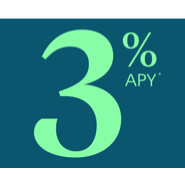Below is a guest post from Evan Mullen.
Digs Savings Account Alternative
The Digs savings account is a unique alternative to the traditional savings account, specifically for future home buyers. With the Digs savings account, interest is paid in the form of a match contribution per month, similar to a 401(k) matching plan (see this page). Additionally, the match that the user earns is tax-free. The account has additional features, such as expert content & advice, a home buyers checklist, and lender recommendations.
The account costs $1/month to use, and has four contribution tiers:
- First $50/month yields 20% matching (maximum of $10)
- Next $100/month yields 10% matching (maximum of $10)
- Next $200/month yields 5% matching (maximum of $10)
- Next $1,000/month yields 1% matching (maximum of $10)
This comes out to a total potential of $40/month if contributing $1,350, or $39/month if considering the monthly fee. These earnings also expire after five years.
The account is FDIC insured up to $250,000. However, the catch is that the match earnings are only accepted as part of a closing cost by a specific network of lenders, who have partnered with Digs. Currently, there are only five lenders in-network (see this page). I spoke to Digs support and they claimed that they would have 10 more in-network lenders by the end of 2019.
Analysis
Two financial considerations when deciding whether to use this account: (1) Total Digs earnings compared to after-tax earnings from the same amount of money in a traditional savings account (2) The best in-network mortgage rate compared to the best out-of-network mortgage rate, and if the difference in interest outweighs the additional earnings in the Digs savings account or not.
I have developed tables to help determine this, since there is a lot that goes into this.
The first analysis calculates an equivalent APY of the Digs savings account, so it can be directly compared to the APY of your current account. In general, the tables show that the fourth Digs tier isn’t even worth contributing to until you are about 12 months away from purchasing a home, with the current APYs being around 2% or more. This also depends on your tax bracket though, so that is why you will see columns corresponding to different tax brackets.
The second analysis determines how much lower an out-of-network lender’s mortgage rate should be to outweigh using an in-network lender (due to the amount you save in paying less interest on your mortgage outweighing the Digs contributions). This analysis assumes that you would be earning the full amount from the Digs account (contributing the maximum to all tiers for five years). Decreasing how much you contribute and/or the duration of your contributions will only make the out-of-network mortgage rate that makes Digs unprofitable move even closer to the in-network mortgage rate (meaning it will be even less likely that using an in-network lender with the Digs match contributions will be more profitable than using an out-of-network lender with a traditional savings account).
Examples
- Example 1: I am in the 22% tax bracket, and I plan on buying my home in 12 months. From the table, I will get 45.17% equivalent APY on the first $50/month I contribute, I will get 24.49% equivalent APY on the next $100/month I contribute, I will get 12.04% equivalent APY on the next $200/month I contribute, I will get 2.38% equivalent APY on the next $1,000/month I contribute.
- Since my current APY is 2.35%, I should contribute to all four tiers.
- Example 2: I am in the 12% tax bracket, and I plan on buying my home in 60 months. From the table, I will get 8.52% equivalent APY on the first $50/month I contribute, I will get 4.91% equivalent APY on the next $100/month I contribute, I will get 2.52% equivalent APY on the next $200/month I contribute, I will get 0.51% equivalent APY on the next $1,000/month I contribute.
- Since my current APY is 2.7%, I should only contribute to the first 2 tiers.
- Example 3: I predict my mortgage will be $200,000. I predict my mortgage rate will be 4.4% from an in-network lender. From the table, the out-of-network mortgage rate to beat is 4.345%.
- Since I believe I can get an out-of-network mortgage rate below 4.345%, using the Digs savings account would not be beneficial.
Final Thoughts
Since there are still many unknowns when deciding to use the Digs savings account or not (such as what mortgage rates will be like when you are ready to purchase a home, APY of traditional savings accounts along the way, etc), it may make more sense to diversify and only contribute to the first tier. This way, if you end up going with an out-of-network lender at the time of home buying, you’ll only have lost out on the interest of $50/month from your traditional savings account. Plus you’ll be able to use the Digs savings account’s other features, like advice from experts.
Thanks to Evan Mullen for this guest post.








Great review Evan! Very thorough analysis!! My favorite part is the last paragraph because it notes the value of the other app features (ie. the educational resources and expert advice.) I think that along with the automation is where the real value is. For some people that education can put them in a much better position when choosing a loan and save on a lot of stress and possibly allow them to negotiate a better deal.
Obviously, with the number of variables, time using the product, future unknowns, and savings tiers, its hard to know the total net value. And every situation is unique. But I think you made a good point that the first tier of 20% is a no brainer. Worst case scenario, you pull your money out and use at an out of network lender. Best case scenario you get an extra $600 towards your downpayment.
Wow, I appreciate the level of this analysis.
The PDF mentions that the max you can earn is $2340 (and that’s assuming a 0% interest alternative.) Honestly I find that number to be the most useful. Do I want to save 81k with Digs to possibly come out ahead $2k, as a best case scenario? I personally don’t. The number is not high enough to offset the fact that I know nothing about how competitive their rates will be vs. outside lenders 5 years from now. Plus do you lose the match if they fold?
Some feedback, I think the examples could have a little more explanation to help them be clearer on their own. As I understand it, Examples 1 & 2 answer a dfiferent question than Example 3. And no example alone is a *complete* example of how you decide if Digs is worth it for you, unless you meet the assumption for Example 3 (max contribution for 5 years, which is stated elsewhere). Although I think I get it now, it took a bit.
Thanks! Yea it is tough to guess what savings interest rates and mortgage rates will be 5 years from now. It was hard to write those examples since I wanted to keep them simple for the reader, yet the analysis demands a pretty in-depth explanation due to the complexity of the account.
The biggest money saver I found when purchasing my house was utilizing a mortgage credit certificate. It’s a essentially a federal tax credit (for the life of the loan and as long as it’s your primary residence) for first time home buyers (just need to have not owned a house within the past 3 years) that are low/moderate income earners (it’s based on median household income in your area, which was like $90k for me 4 years ago). It varies by state, but 4 years ago (it has since changed) PA was offering a 50% tax credit rate, which essentially gives you back 50% of interest paid (again, for the life of the loan) capped at $2000/year. For example, the first couple years of my loan, the annual interest is over $4000, so I’m getting back $2000 as a credit (not deduction) each of those years. Once my annual interest paid drops below that, say $3990, I’ll get back $1995. Obviously, towards the end of your loan, when you’re paying very little interest, the credit has a much smaller effect.
Yeah, I just happened to find out about the TX version of that a few days ago. Unfortunately it is very restricted availability here. The state now only offers it to people who get a specific type of mortgage (only available through certain lenders, which are probably not going to overlap with the ‘Digs’ list) for low-income first-time buyers. The Stand-Alone Mortgage Credit Certificate is now only available in a few cities/counties in the state.
Everyone should definitely google their state’s name with ‘Mortgage Credit Certificate’ to see if their state is more generous with these, though! Most people who would qualify have probably never heard of MCCs before.
This is an excellent write-up and a very worthwhile post, but this doesn’t seem like the best product for me, especially with the lack of clarity from the website and I’m not going to give them my information to even be able to read the fine print.
While the match looks great there are so many catches.
The limit of only 5 in network lender is huge risk.
The match expires in 5 years (please make that statement bold or something. I missed that when first reading the article). Theoretically, you can get a max of $40*12*5 = $2400 to cover closing cost after depositing $1,350*12*5 = $81,000.
Also you will lose match in 1:5 rate if you withdraw cash. i.e. you lose $100 in match if you withdraw $500.
My initial gut feeling is that doing the $200 tiers and below may be worthy a small experiment. You contribute $350 per month for a $30 match, that maxes it $350 *12*5 = $21,000 contribution and $30*12*5 = $1800 match.
However a quick math using $350 per month contribution to a 2.5% APY saving shows about $22,700 after 5 years. Therefore you barely break even with digs match that is attached to many strings.
The Digs match is tax free, so that boosts the advantage. But still not enough to make up for all the strings, IMO.
Thanks for the post Evan. I don’t think this is a very attractive product because of how complex it is (and how badly explained it is on their site). $39/month of earnings would be great, but with earnings expiring after 5 years and the restrictive lender choice, there’s really no upside to using their system. Any deviation in interest rate between their approved lenders and say a credit union would render the savings moot.
There’s also an opportunity cost of just putting the cash in a certificate. Some are paying up to 3.5% apy. Just deposit and done. No tiers or schedule or any monthly fees to worry about.
It’s a cool idea but they really just killed it with the monthly fee and 5 year expirations. Also, the match isn’t guaranteed or FDIC insured. The only certainty is losing $1/month for a subpar savings account.
You’re welcome and agreed! I only realized after already completing my first analysis that the second analysis basically makes the first analysis unnecessary. I thought why not include both analyses anyway haha. The decrease in mortgage rate is so small that I assume you will always be able to find a better out-of-network lender.
Feel free to reach out with any additional questions regarding my analysis: [email protected]
I would like to personally thank you for your in-depth analysis. I haven’t the time to check it for total accuracy, but you obviously but in some time thinking about it, researching it, and writing the scripts.
You’re welcome! I enjoyed doing it, and I truly wanted to accurately know if using the Digs account was worth it or not. Glad to be able to share it with others now as well.